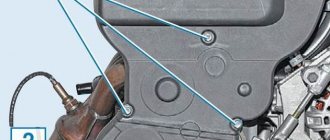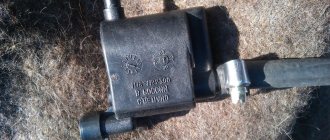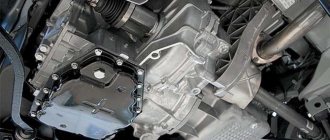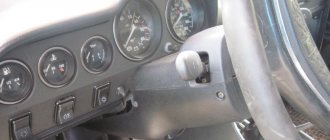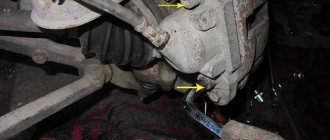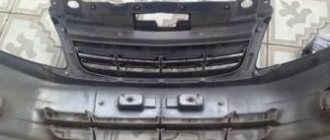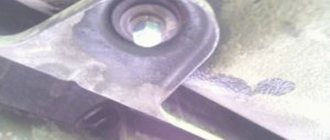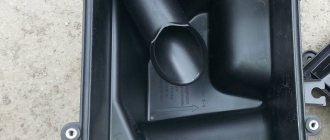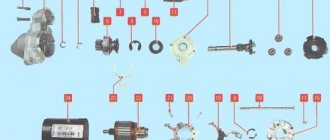Many car owners may be interested in the question of how to check the adsorber and its purge valve when the diagnostics showed it to be faulty (an absorber error popped up). It is quite possible to make such a diagnosis in a garage, however, for this it will be necessary to dismantle either the entire adsorber or only its valve. And to carry out such a test, you will need metalworking tools, a multifunctional multimeter (to measure the insulation value and the “continuity” of the wires), a pump, and a 12 V power source (or a similar battery).
What is an adsorber for?
Before moving on to the question of how to check the operation of the adsorber, let us briefly describe the operation of the gasoline vapor recovery system (in English called Evaporative Emission Control - EVAP). This will give a clearer picture of the functions of both the adsorber and its valve. So, as the name implies, the EVAP system is designed to capture gasoline vapors and prevent them from entering the surrounding air unburned. Vapors are formed in the fuel tank when gasoline is heated (most often during long-term parking under the scorching sun in the warm season) or when atmospheric pressure decreases (very rarely). The task of the fuel vapor recovery system is to return these same vapors to the engine intake manifold and burn them along with the air-fuel mixture. As a rule, such a system is installed on all modern gasoline engines in accordance with the Euro-3 environmental standard (adopted by the European Union in 1999).
The EVAP system consists of the following elements:
- carbon adsorber;
- adsorber purge solenoid valve;
- connecting pipelines.
There are also additional wiring harnesses leading from the electronic engine control unit (ECU) to the said valve. With their help, this device is controlled. As for the adsorber, it has three external connections:
- with the fuel tank (through this connection, the generated gasoline vapors directly enter the adsorber);
- with an intake manifold (it is used to purge the adsorber);
- with atmospheric air through the fuel filter or a separate valve at its inlet (provides the pressure drop necessary to purge the adsorber).
The adsorber is a kind of barrel (or similar vessel) that is filled with ground coal, in which gasoline vapors actually condense, after which they are sent to the car's power system as a result of purging. Long and proper operation of the adsorber is possible only with its regular and sufficient ventilation. Accordingly, checking the car adsorber is to check its integrity (since the body may rust) and the ability to condense gasoline vapors. Even older adsorbers pass the carbon contained in them through their system, which clogs both the system and their purge valve.
The solenoid valve for purge the adsorber directly purges the system from gasoline vapors present in it. This is done by opening it upon command from the ECU, that is, the valve is an actuator. It is located in the pipeline between the adsorber and the intake manifold.
As for checking the adsorber valve, firstly, it is checked that it is not clogged with coal dust or other debris that can get into the fuel system when it is depressurized from the outside, as well as with coal from the adsorber. And secondly, its functionality is checked, that is, the ability to open and close on a command coming from the electronic engine control unit. Moreover, not only the presence of the commands themselves is checked, but also their meaning, which is expressed in the time during which the valve must be open or closed.
Interestingly, in engines equipped with a turbocharger, a vacuum is not created in the intake manifold. Therefore, for the system to operate, it is provided with another two-way valve that operates and directs fuel vapor into the intake manifold (if there is no boost pressure) or to the compressor inlet (if there is boost pressure).
Please note that the canister solenoid valve is controlled by an electronic unit based on a large amount of information from temperature sensors, mass air flow, crankshaft position and others. In fact, the algorithms by which the corresponding programs are built are quite complex. It is important to know that the greater the engine air consumption, the longer the duration of the control pulses from the ECU to the valve and the stronger the canister purge.
That is, what is important is not the voltage supplied to the valve (it is standard and equal to the total voltage in the automotive electrical network), but its duration. There is such a thing as “adsorber purge duty cycle”. It is scalar and is measured from 0% to 100%. A zero threshold indicates that there is no purging at all, respectively, 100% means that the adsorber is purged as much as possible at a given time. However, in reality this value is always somewhere in the middle and depends on the operating conditions of the machine.
Also, the concept of duty cycle is interesting because it can be measured using special diagnostic programs on a computer. An example of such software is the Chevrolet Explorer or OpenDiag Mobile programs. The latter is perfect for checking the adsorber of domestic cars VAZ Priora, Kalina and other similar models. Please note that an additional scanner, such as an ELM 327, is required to use the mobile application.
Malfunctions in the fuel vapor recovery system Lada Kalina
Why do you need a check valve on a fuel pump and how to replace it yourself?
Since the solenoid valve itself is not a complex device, it has few malfunctions as such - it may not open or close when necessary, or it may get stuck in some certain position. But the culprit of the breakdown may not only be Evap-Solenoid; the gasoline vapor recovery system does not work correctly for other reasons:
- connecting pipes are pinched or clogged;
- normal vacuum is not created in the system;
- due to an open circuit, there is no voltage on the valve;
- the carbon filter is completely clogged (which is rare);
- The control unit malfunctions.
If the CPA is stuck in the open position and does not block the channel, the following defects may occur:
- the fuel mixture becomes richer, causing “blackness” to appear on the electrodes of the spark plugs;
- the engine begins to operate unstably, this is especially noticeable at idle;
- gasoline consumption increases;
- The throttle response of the internal combustion engine decreases.
When the EVAP channel is constantly blocked by the purge valve, excess vapor pressure is created in the gas tank, due to this:
- there is a risk of fuel pump failure;
- The fuel level sensor may fail.
It should be noted that purge occurs in a certain mode after starting the engine, the program is executed depending on the crankshaft speed, and the system does not work at idle. An impulse arrives at the CPA if:
- the coolant has heated to a temperature of at least 75 degrees Celsius;
- the throttle valve is open at least 4%;
- the car is moving at a speed of more than 10 km/h (but this is not a necessary condition).
Problems in the electrical part of the EVAP are detected by the control unit, and the Check Engine warning lamp lights up on the instrument panel. The fault code can be determined using a special diagnostic scanner or a computer with a program installed; the most common errors in the vapor recovery system detected by the diagnostic device are P0441 and P0455.
External signs of malfunction
Before checking the adsorber purge valve, as well as the adsorber itself, it will certainly be useful to find out what external signs accompany this fact. There are a number of indirect signs, which, however, can be caused by other reasons. However, when identifying them, it makes sense to also check the operation of the EVAP system, as well as its constituent elements.
- Unstable engine operation at idle speed (the speed “floats” to the point where the car starts and stalls, because it runs on a lean air-fuel mixture).
- A slight increase in fuel consumption, especially when the engine is running “hot”, that is, in a warm state and/or in hot summer weather.
- It is difficult to start a car engine when it is hot; it is usually impossible to start it the first time. And at the same time, the starter and other elements associated with starting are in working condition.
- When the engine operates at low speeds, the loss of power is very noticeable. And at higher speeds there is also a decrease in torque.
In some cases, it is noted that if the normal operation of the gasoline vapor recovery system is disrupted, the smell of fuel may enter the cabin. This is especially true when the front windows are open and/or when the car is parked for a long time in a closed box or garage with poor ventilation. Also, poor operation of the system is caused by depressurization of the fuel system, the appearance of small cracks in fuel lines, plugs, and so on.
Addresses of companies providing installation/replacement services (Moscow, St. Petersburg, Kyiv region)
| № | Name | Address |
| 1. | "Diesel Master" | Russia, St. Petersburg, Moskovskoe highway, 13A, Zvezdnaya metro station |
| 2. | "Author+" | Russia, St. Petersburg, Mineralnaya str., 13O, Vyborgskaya metro station |
| 3. | "Service Team" | Car service, automatic transmission repair, tire side cut repair, car air conditioner repair, Strogino metro station, Marshala Proshlyakova street, 12k1s1 |
| 4. |
Car services, repair of electronic vehicle control systems, repair of electrical equipment, repair of fuel equipment for diesel engines, metro station Gagarina Square, Vavilova, 13a, 1st floor
5. “Kulibins” Kyiv, st. Borova 2/38
6. “Renault-Life” Kyiv, st. Novokonstantinovskaya, 1 G
How to check the adsorber
Now let’s move directly to the algorithm for checking the adsorber (its other name is the fuel vapor accumulator). The main task in this case is to determine how sealed its body is and whether it allows fuel vapors to escape into the atmosphere. So, the check must be performed according to the following algorithm:
- Disconnect the negative terminal from the vehicle battery.
- First, disconnect all hoses and contacts going to it from the adsorber, and then remove the fuel vapor accumulator directly. This procedure will look different for different machines, depending on the location of the assembly, as well as the mounting means with which it was secured.
- It is necessary to plug (seal) the two fittings tightly. The first one goes directly to atmospheric air, the second one goes to the solenoid purge valve.
- After this, use a compressor or pump to apply a slight air pressure to the fitting going to the fuel tank. Don't overdo it with pressure! A working adsorber should not leak from the housing, that is, be sealed. If such leaks are detected, then most likely the unit needs to be replaced, since it is not always possible to repair it. In particular, this is especially true if the adsorber is made of plastic.
Removing and installing the adsorber on Lada Vesta
After analyzing the entire fuel vapor collection system to find a fault, determine the part that needs to be replaced. The purge valve most often fails and becomes the “culprit” for a knock that can be heard even inside the car. Replacing the adsorber on a car should be done according to the following algorithm:
- Stop the car in place and open the hood. The part you need is near the right wing.
- Disconnect the wires. First move the retainer stopper upwards and tighten it so that the wires are released smoothly.
- Clamp the spring clips securing the tube to the intake module and disconnect it.
- Do the same with the valve pipe and the wire connected to the adsorber.
- Remove the valve. Put a new part in its place.
How to check the adsorber valve
If after checking it turns out that the adsorber is in more or less working condition, then it makes sense to check its purge solenoid valve. It’s worth mentioning right away that for some machines, due to their design, some actions will differ, some of them will be present or absent, but in general the verification logic will always remain the same. So, to check the adsorber valve, you must perform the following steps:
- Visually check the integrity of the rubber hoses included in the fuel vapor recovery system, in particular those directly approaching the valve. They must be intact and ensure the tightness of the system.
- Disconnect the negative terminal from the battery. This is done to prevent false alarms of the system diagnostics and to enter information about the corresponding errors into the electronic control unit.
- Remove the absorber (usually it is located on the right side of the engine, in the area where the air system elements are installed, in particular the air filter).
- Turn off the electrical power to the valve itself. This is done by removing the electrical connector (the so-called “chip”) from it.
- Disconnect the inlet and outlet air hoses from the valve.
- Using a pump or medical bulb, you must try to blow air into the system through the valve (into the holes for the hoses). It is important to ensure the tightness of the air supply. To do this, you can use clamps or a thick rubber tube.
- If everything is in order with the valve, it will be closed and air will not be blown through. Otherwise, its mechanical part will fail. You can try to restore it, but this is not always possible.
- It is necessary to supply electric current from the power supply or battery using wires to the valve contacts. At the moment the circuit closes, you should hear a characteristic click, which signals that the valve has actuated and opened. If this does not happen, then perhaps instead of a mechanical failure there is an electrical failure, in particular, its electromagnetic coil has burned out.
- With the valve connected to an electric current source, you must try to blow air into it in the manner described above. If it is working properly, and therefore open, then this should work without problems. If it is not possible to pump through air, then the valve has failed.
- Next, you need to reset the power from the valve, and there will be a click again, indicating that the valve has closed. If this happens, it means the valve is working.
You can also check the adsorber valve using a multifunctional multimeter, switched to ohmmeter mode - a device for measuring the insulation resistance value of the electromagnetic winding of the valve. The probes of the device must be placed at the coil terminals (the places where the wires coming from the electronic control unit are connected to it; there are various design solutions), and the insulation resistance between them must be checked. For a normal, serviceable valve, this value should be within approximately 10...30 Ohms or differ slightly from this range. If the resistance value is small, it means that there is a breakdown of the electromagnetic coil (short interturn circuit). If the resistance value is very large (calculated in kilo- and even mega-ohms), then the electromagnetic coil breaks. In both cases, the coil, and therefore the valve, will be unsuitable for use. If it is sealed into the housing, then the only way out of the situation will be to completely replace the valve with a new one.
Thus, in order to know how to check whether the adsorber valve is working properly, you need to dismantle it and check it in a garage. The main thing is to know where its electrical contacts are located, and also to perform a mechanical inspection of the device.
Error P0441
Owners of Lada Kalina often note that during the operation of the car, error P0441 appears, indicating that the gasoline vapor purge system is not operating correctly (the air flow differs from the norm). The cause of this malfunction may be:
- inoperative adsorber valve;
- clogging of the air line from the control unit to the air filter;
- air leakage through connecting pipes.
What should not be immediately considered is the line from the gas tank to the adsorber; here, a breakdown does not in any way affect the readings of the computer or diagnostic scanner. Still, most often Evap-Solenoid fails; this is a characteristic “disease” on Kalina.
If the EVAP valve stops functioning normally, it is not at all necessary that the engine will lose power, the fuel pump will fail, and so on. Mainly due to problems with the control gear, exhaust toxicity increases, and the Check Engine on the dashboard periodically lights up. There are car owners who do not pay attention to the diagnostic warning light, continuing to operate the car, but do not experience any great inconvenience. And most often in such a case, gasoline consumption does not exceed the norm, the engine starts normally, and no serious problems occur in the fuel system.
1200 rub. for the photo report
We pay for photo reports on car repairs. Earnings from 10,000 rubles/month.
Write:
Many car owners may be interested in the question of how to check the adsorber and its purge valve when the diagnostics showed it to be faulty (an absorber error popped up). It is quite possible to make such a diagnosis in a garage, however, for this it will be necessary to dismantle either the entire adsorber or just its valve. And to carry out such a test, you will need metalworking tools, a multifunctional multimeter (to measure the insulation value and the “continuity” of the wires), a pump, and a 12 V power source (or a similar battery).
How to repair the adsorber and valve
It’s worth noting right away that in most cases both the adsorber and the valve cannot be repaired; accordingly, they need to be replaced with similar new units. However, as for the adsorber, in some cases, over time, the foam in its body rots, which is why the carbon contained in it clogs the pipelines and the solenoid valve of the EVAP system. Rotting of foam rubber occurs for banal reasons - from old age, constant temperature changes, exposure to moisture. You can try to replace the foam separator of the adsorber. However, this cannot be done with all units; some of them are non-separable.
If the adsorber body is rusted or rotten (usually also due to old age, temperature changes, constant exposure to moisture), then you can try to restore it, but it is better not to tempt fate and replace it with a new one.
Similar reasoning is valid for the solenoid valve of the gasoline vapor recovery system. Most of these units are non-separable. That is, the electromagnetic coil is sealed into its body, and if it fails (insulation breakdown or winding break), it will not be possible to replace it with a new one. Same with the return spring. If it has weakened over time, you can try to replace it with a new one, but this is not always possible. But despite this, it is still better to perform a detailed diagnosis of the adsorber and its valve in order to avoid expensive purchases and repairs.
Some car owners do not want to pay attention to the repair and restoration of the gasoline vapor recovery system, and simply “turn off” it. However, this approach is not rational. Firstly, this really affects the environment, and this is especially noticeable in large cities, which are not known for their clean environment anyway. Secondly, if the EVAP system does not work correctly or does not function at all, then under pressure gasoline vapors will periodically escape from under the gas tank cap. And this will happen as often as the temperature in the gas tank increases. This situation is dangerous for several reasons.
What is a filter element and how does it work?
In simple terms, the absorber is a large can filled with activated carbon. In addition, the system contains:
- Separator with gravity valve. It is responsible for trapping fuel particles. The gravity valve, in turn, is used very rarely, but in an emergency (for example, if the car overturned during an accident), it will prevent fuel from overflowing from the gas tank.
- Pressure meter. It is necessary to control the level of gasoline vapor in the tank. As soon as their level is exceeded, harmful components are released.
- Filter part. In fact, this is the same can of granular activated carbon.
- Solenoid valve. Used to switch between modes for capturing emitted gasoline vapors.
If we talk about the principle of operation of the system, it is very simple:
- First, gasoline vapors rise in the gas tank and are sent to a separator, where partial condensation of the fuel occurs, which is sent back to the gas tank in liquid form.
- That part of the vapor that could not settle in the form of liquid passes through a gravity sensor and is sent to the adsorber.
- When the car engine is turned off, gasoline vapors begin to accumulate in the filter element.
- As soon as the engine starts, the canister valve comes into play, which opens and connects the canister to the intake manifold.
- Gasoline vapors are combined with oxygen (which enters the system through the throttle assembly) and pass into the intake manifold and engine cylinders, where harmful fumes burn out along with air and fuel.
As a rule, it is the adsorber valve that fails. If it begins to open and close in the wrong mode or fails completely, this can negatively affect the operation of the entire vehicle and cause breakdowns.
Purpose
This spare part was not always part of the car. We owe its appearance to modern requirements for the environmental performance of cars, and to be more precise, the Lada Granta acquired an adsorber thanks to Euro-3.
(Euro-3 is an environmental standard that was introduced in 1999, but Russian manufacturers were able to meet its requirements only in 2008.)
The adsorber, for which Granta became one of the first “shelters” in the domestic automotive market, is a spare part directly connected to the catalyst. It allows you to accumulate gasoline vapors to prevent them from entering the exhaust manifold.
Such actions allow you to preserve the catalyst and prevent its premature wear, since the combination of a cold catalyst with gasoline vapor is unacceptable. As soon as the engine warms up to the required temperature, the adsorber purge sensor is activated. The adsorber valve drives the vapors back into the gas tank.
Additional features
Of course, initially, created to create environmentally friendly engine operation, the Lada Granta adsorber, the price of which is insignificant, was underestimated. Manufacturers tried with all sorts of tricks to circumvent this newfangled trend, but the law obliged all car manufacturers who did not comply with this innovation to pay heavy fines.
Although AvtoVAZ has never been known for its large exports, it was forced to take measures to install an adsorber, since it has a small, but still a sales market. Today, the adsorber is installed on the Lada Granta without fail, since world research has revealed the following capabilities of this component:
– reduction in gasoline consumption
A similar result is achieved because the adsorber valve allows gases to be driven back into the gas tank, from where they enter the engine, which, when warm, is capable of processing them. If this device is missing, or the canister valve itself does not work, Granta loses fuel, which significantly increases consumption.
– normalization of exhaust system operation
Thanks to filtration, the likelihood of premature wear of the system and its components disappears.
Valve - as the most important component of the device
Speaking about how the adsorber valve works, it is necessary to introduce the device itself. It is, roughly speaking, a can of coal, which is equipped with a valve that allows the vapor to condense and direct. The canister purge valve is controlled by the ECU, which sends a signal to open/close it.
Important. The adsorber solenoid valve can create certain troubles for the driver. In the cold season, when starting a cold engine, a certain sound similar to clicking may be heard. This sound is normal, since the valve may not work correctly when cold.
In order not to confuse this sound with possible breakdowns, it is necessary to apply gas control. If there are no changes, you can safely attribute the clicks to the absorber.
Features of valve operation
The Grant canister purge valve itself was inherited from Kalina. Thus, the Kalina adsorber purge valve and the Lada Granta adsorber purge valve are completely identical. This allows us to assert that the signs of adsorber malfunction in both cars are identical.
If we take into account the Kalina adsorber purge solenoid valve, malfunctions and their symptoms can be completely attributed to a malfunction of the adsorber of its younger brother.
How to understand a malfunction of the absorber
Speaking about the adsorber valve, the symptoms of a malfunction will be fairly standardized, which makes it possible to obtain a fairly detailed description. So, signs of a malfunctioning adsorber valve:
– Constant smell of gasoline in the cabin.
This fact is caused by improper circulation of gases, which may have a certain leakage. Due to the proximity of the system to the air filter, odors freely penetrate into the cabin.
Signs of a malfunction of the canister purge valve on the Grant include this sound, familiar to all Grant owners.
(to fix this, you can tighten the nut, or you can purchase a new one; fortunately, the Lada Granta adsorber valve, the price of which is low, is available for purchase)
– Increased fuel consumption.
An inoperative adsorber ventilation valve is not able to control the correct path of gases, which does not allow them to be processed in the form of combustion.
– The amount of harmful substances released through the system increases.
Speaking about how the canister purge valve works and why, do not forget that increasing the environmental performance of a car is a primary task, which can be disrupted if the canister purge solenoid valve does not function correctly.
- Sounds similar to some hissing.
Strong hissing in the adsorber hose, the cause of which is the accumulation of gases, is not uncommon. Since modern requirements for cars do not allow gas emissions while parked, a certain accumulation is acceptable.
– Characteristic sounds coming from the gas tank.
Speaking about the Lada Granta adsorber, the malfunction of which is always characterized by extraneous sounds coming from the gas tank, it must be said that they are the most typical sign of a breakdown. In this case, the adsorber sensor may not give any indicators of malfunction, therefore, it must also be replaced.
Thus, signs of a malfunction of the Lada Grant canister purge valve are quite easy to identify. In addition, they are detected when simply refueling the car, which necessarily requires opening the gas tank cap.
How to repair a problem
When talking about repairing the adsorber, the fault should be clearly identified. For example, if we are talking about the Grant adsorber purge valve, the malfunction of which can be indexed by the lack of high-quality gas removal, a new VAZ adsorber purge valve can be a solution to the problem.
The repair of the adsorber valve itself comes down to using a Phillips screwdriver and its application. The procedure for influencing the Lada Granta adsorber sensor:
1) We remove the terminals so that there are no disastrous consequences.
2) Apply physical force and gently remove the valve.
3) We compare the new valve and the old one, because anything can happen in life. Buying an adsorber valve, of course, is a simple thing, but there are mistakes made by sellers/storekeepers who may mistakenly sell an unnecessary spare part.
4) We insert a new valve, assemble this system, return the terminals to their place and enjoy life. The Grant adsorber purge valve, the price of which is almost equally low throughout the Grant sales area, is also a reason for a small, but still joy.
It is impossible in the course of the story about the adsorber not to mention the fact that a huge number of Lada Grant owners prefer to remove this device. There are two reasons for this action:
– lack of desire to repair
– lack of faith in the possible environmental benefits of installing this device in your car
Replacing the canister purge valve on a Lada Granta with your own hands
Sometimes, when the CPA is jammed, it is possible to “bring it back to life” by flushing; for this, they use either carburetor flushing fluid or a regular WD carburetor. But the result is not always there, so you shouldn’t count on it too much. If after washing everything remains the same, you will have to replace the adsorber purge valve. This is done as follows.
In the store we buy a new control unit, as well as two small clamps and a hose of a suitable diameter, usually a fuel hose is suitable. We take a minimum set of tools (screwdriver, knife, pliers) and get to work, the whole process will take you no more than half an hour.
- The first thing to do is to remove the air corrugation from the air vent body; to do this, take a screwdriver and loosen the clamps. We remove the pipe and under all this equipment we find our valve.
- We disconnect the KPA mount and turn off its power; it has a block with a latch that you need to press on. Then disconnect the canister valve pipes one by one.
- One hose is the one made of “oak” plastic, put on a fitting, you can simply cut it off, don’t try to remove it, even if everything works out, it won’t stick tightly to the new valve. Moreover, we have everything provided and a new pipe has been prepared. If you really want to, you can use sealant and try to seal the connection of the old hose with it.
- We remove all quick-release connections and twist them onto the new hose. It is important not to mix up the hoses and connectors themselves, so as not to disrupt the operation of the ventilation system.
We assemble everything in the reverse order and fasten the air duct pipe in place. Next, start the engine and make sure that the problem has disappeared. It is better to erase the error first.
I’ll end here, as you can see, there’s nothing complicated. Replacing the canister purge valve is not much more difficult than replacing the air filter. Try it and you will definitely succeed. If the article was useful to you, share the link to it with your loved ones by copying the link for social networks or using the special buttons below. I would also be grateful if you leave a meaningful comment. Goodbye everyone and see you again at VAZ Repair.
Price policy
Speaking about the Grant adsorber purge valve, which can be purchased today in all large and not so large places for selling spare parts for the Russian auto industry, it is impossible not to note its pleasant price. The Grant adsorber valve, the price of which is equivalent to the probability of its failure, allows for independent replacement and is a simple mechanism.
Thus, maintaining the environmental standards of the Lada Granta is truly a man-made matter. The adsorber has become a part that, in addition to caring for the environment, can significantly reduce fuel consumption and improve the operation of exhaust gas removal.
Checklist: main malfunctions of the adsorber
First of all, if any part of this system is faulty, a “check” will almost always light up on the panel.
Checking through the diagnostic connector will produce errors P0443, P0444, P0458, P0459.
Deciphering these codes shows the specific cause of the problem in the system. A malfunction of a part of the fuel vapor collection system manifests itself in another way:
- The adsorber valve on the Lada Vesta is knocking - it’s true. Often this occurs due to deformation, and therefore failure, but in winter, increased knocking may be a consequence of the fact that the lid has simply frozen and hardened, causing the sound to become louder.
- If the adsorber on a Lada Vesta is loud, this is not always normal. When accelerating sharply, a “throttle failure” is heard and felt. This is the first sign that vapors are not collecting in the container - the ECU sends a signal, but there is simply nothing to enrich the mixture with.
- When you open the fuel tank, you hear a hissing that is not typical for Vesta. This is the second evidence that the vapors do not collect under the hood, but remain in the tank. The malfunction may be caused by a check valve, sensor, or purge valve.
- At idle, the speed literally “jumps”, “floats”. The engine may even stall.
